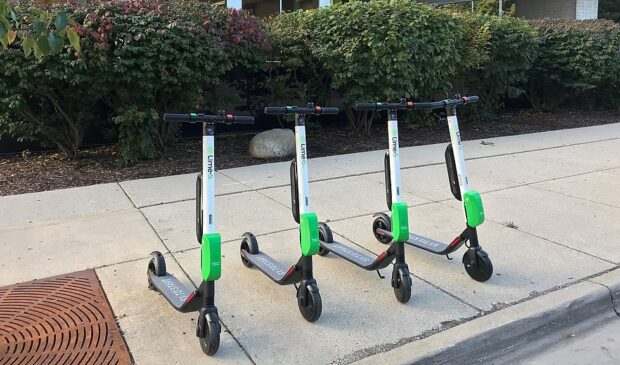City touts ongoing success in one-year update on micromobility program tweaks
Tuesday, April 22, 2025 by
Miles Wall Last April, Austin made changes to its micromobility program, cutting the number of scooters on the street by 2,000 and reducing speed limits among other things. In a one-year update, city staff say those changes have worked out as well as or better than expected.
In a presentation to City Council’s Mobility Committee during a public meeting on April 17, Transportation and Public Works department officials laid out new data that shows a modest decline in overall trips citywide, but a significant boost in trips per vehicle per day, which the city records as TVD.
Mike Kimbro, the department’s program manager overseeing micromobility, said that’s what the city had hoped for.
“One of the goals with this reduction we did (last April) was hopefully, we would see those numbers increase,” Kimbro said, referring to the reduction in the maximum fleet size and the trips per day metrics, respectively. “And we did, citywide,” he added.
Kimbro cited the data, which shows an increase citywide from 1.21 trips per day to 1.36, and a downtown-specific jump from 1.10 to 1.79. Those numbers came in the context of a 30 percent citywide and 45 percent downtown decrease in the total number of scooters available.
That means that on average, each scooter is getting more use — and spending less time cluttering up city streets and sidewalks. The total number of trips has also declined by 2.3 percent citywide and 9.4 percent downtown, which Kimbro noted “wasn’t that dramatic” compared to the reduction in fleet size or the increases in trips per day.
The data also shows a sharp drop in customer service requests to the city’s 3-1-1 system related to improperly parked scooters. Kimbro noted that not all of that drop could be attributed to the changes, referring to “robust enforcement” in 2023 that resulted in an “inflated” number of 3-1-1 calls made by parking enforcement employees.
The numbers are in line with a previous update in December reported on by the Austin Monitor that showed a similar trajectory. That update also touched on other micromobility issues including parking, safety and data collection, which were further expanded on during the meeting on April 17.
Staff discussed budding efforts to record complaints about improperly parked scooters in the city’s Knack data system, a proprietary tool used by the department to track other traffic and parking issues, and an effort to collaborate with the Emergency Medical Services Department to track how many scooter-related crashes paramedics have been called out on to get a better picture of safety.
“There’s a lot more work to be done to integrate and connect (EMS data) with existing crash report data from police or existing hospital data that we know,” said Lewis Leff, the interim assistant director for transportation and public works, in response to a question on safety data from Councilmember Zo Qadri. “But I think there is a goal to be able to look back in time to be able to establish a baseline.”
Qadri also asked about previously shared plans for scooter parking corrals. Kimbro said the department had “tabled” the idea for the time being in favor of more cost-effective alternatives, like painted-on parking boxes. However, he said the department would likely take up the physical corrals again “in fiscal year 2026.”
Wider changes to the micromobility program may come soon from updates in the works to transportation and public works’ director’s rules. Kimbro said the department hopes to put new rules into action starting in July, after conducting more outreach and receiving feedback from city commissions and Council.
Some possible changes teased in the presentation to the Mobility Committee are more robust data reporting requirements for Lime, Bird and other providers, standardization of terminology to make interpreting that data easier, and further tweaks to rules around fleet size and permitting.
Photo by Baldesteinemanuel326, CC BY-SA 4.0, via Wikimedia Commons.
The Austin Monitor’s work is made possible by donations from the community. Though our reporting covers donors from time to time, we are careful to keep business and editorial efforts separate while maintaining transparency. A complete list of donors is available here, and our code of ethics is explained here.
You're a community leader
And we’re honored you look to us for serious, in-depth news. You know a strong community needs local and dedicated watchdog reporting. We’re here for you and that won’t change. Now will you take the powerful next step and support our nonprofit news organization?




